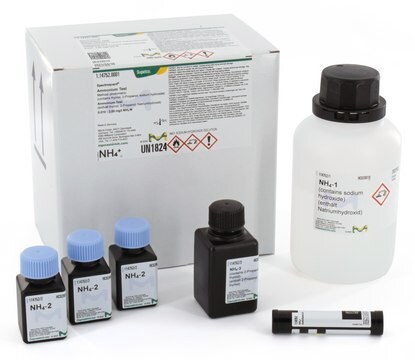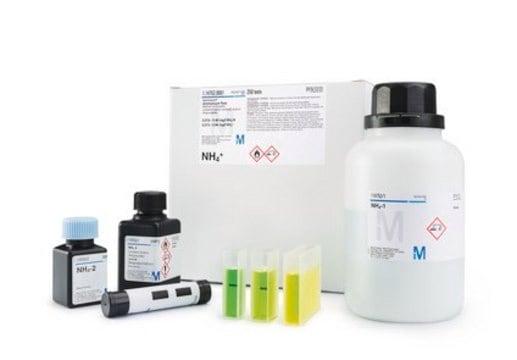1.14897
Chloride Test, photometric
photometric, 2.5-250 mg/L (Cl-), Spectroquant®
About This Item
Recommended Products
product name
Chloride Test, photometric, 2.5-250 mg/L (Cl-), Spectroquant®
product line
Spectroquant®
Quality Level
usage
sufficient for 100 tests
sufficient for 175 tests (depending on package size)
specific analyte(s)
chloride
measuring range
2.5-250 mg/L (Cl-)
technique(s)
photometry: suitable
compatibility
for use with Spectroquant® Move 100
for use with Spectroquant® Nova 60 A
for use with Spectroquant® Prove 100
for use with Spectroquant® Prove 300
for use with Spectroquant® Prove 600
detection method
photometric (Iron(III)-thiocyanate)
storage temp.
15-25°C
General description
This Spectroquant® Chloride test allows the accurate quantification of chloride ions in various waters and waste water. Their concentration depends on geological factors and the general local situation. Within the test chloride ions react with mercury(II)-thiocyanate to mercury(II) chloride. The liberated thiocyanide reacts with iron ions to form a read complex. The method is analogous to EPA 325.1 and APHA 4500-Cl- E.
All our Cell and Reagent Test Kits are equipped with the unique Live ID (2D barcode) which allows seamless method recognition and contains essential information such as lot number, expiry date, and automatic calibration updates.
The Spectroquant® Reagent Test Kits contain highly stable, ready-to-use reagent mixtures to perform the analysis according to the procedure described in the accompanying instruction leaflet.
Application
- PREFUL MRI for Monitoring Perfusion and Ventilation Changes after Elexacaftor-Tezacaftor-Ivacaftor Therapy for Cystic Fibrosis: A Feasibility Study.: This study demonstrates the use of PREFUL MRI to monitor changes in perfusion and ventilation in cystic fibrosis patients post-therapy, showcasing its potential for non-invasive assessment in clinical settings (Dohna et al., 2024).
- Wearable sweat chloride sensors: materials, fabrication and their applications.: Reviews advances in materials and fabrication techniques for wearable sweat chloride sensors, discussing their significant potential for real-time health monitoring and diagnostics (Patel et al., 2024).
- Initial characteristics of cystic fibrosis in Algeria: Description of 34 pediatric cases.: Provides an overview of the clinical presentation and initial characteristics of cystic fibrosis in a pediatric Algerian cohort, contributing to the regional understanding of this genetic disorder (Bendoukha et al., 2024).
Legal Information
signalword
Danger
Hazard Classifications
Acute Tox. 3 Dermal - Acute Tox. 4 Inhalation - Acute Tox. 4 Oral - Aquatic Acute 1 - Aquatic Chronic 1 - Eye Dam. 1 - Met. Corr. 1 - Skin Corr. 1B - STOT RE 2
Storage Class
6.1A - Combustible, acute toxic Cat. 1 and 2 / very toxic hazardous materials
wgk_germany
WGK 3
flash_point_f
188.6 °F
flash_point_c
87 °C
Certificates of Analysis (COA)
Search for Certificates of Analysis (COA) by entering the products Lot/Batch Number. Lot and Batch Numbers can be found on a product’s label following the words ‘Lot’ or ‘Batch’.
Already Own This Product?
Find documentation for the products that you have recently purchased in the Document Library.
Customers Also Viewed
Protocols
Photometric determination using the iron(III)/mercury thiocyanate method after fusion melting
Related Content
Clean drinking water is essential for food and beverage production. This article gives an overview of chemical and microbiological testing of the drinking water for quality and safety.
Our team of scientists has experience in all areas of research including Life Science, Material Science, Chemical Synthesis, Chromatography, Analytical and many others.
Contact Technical Service







